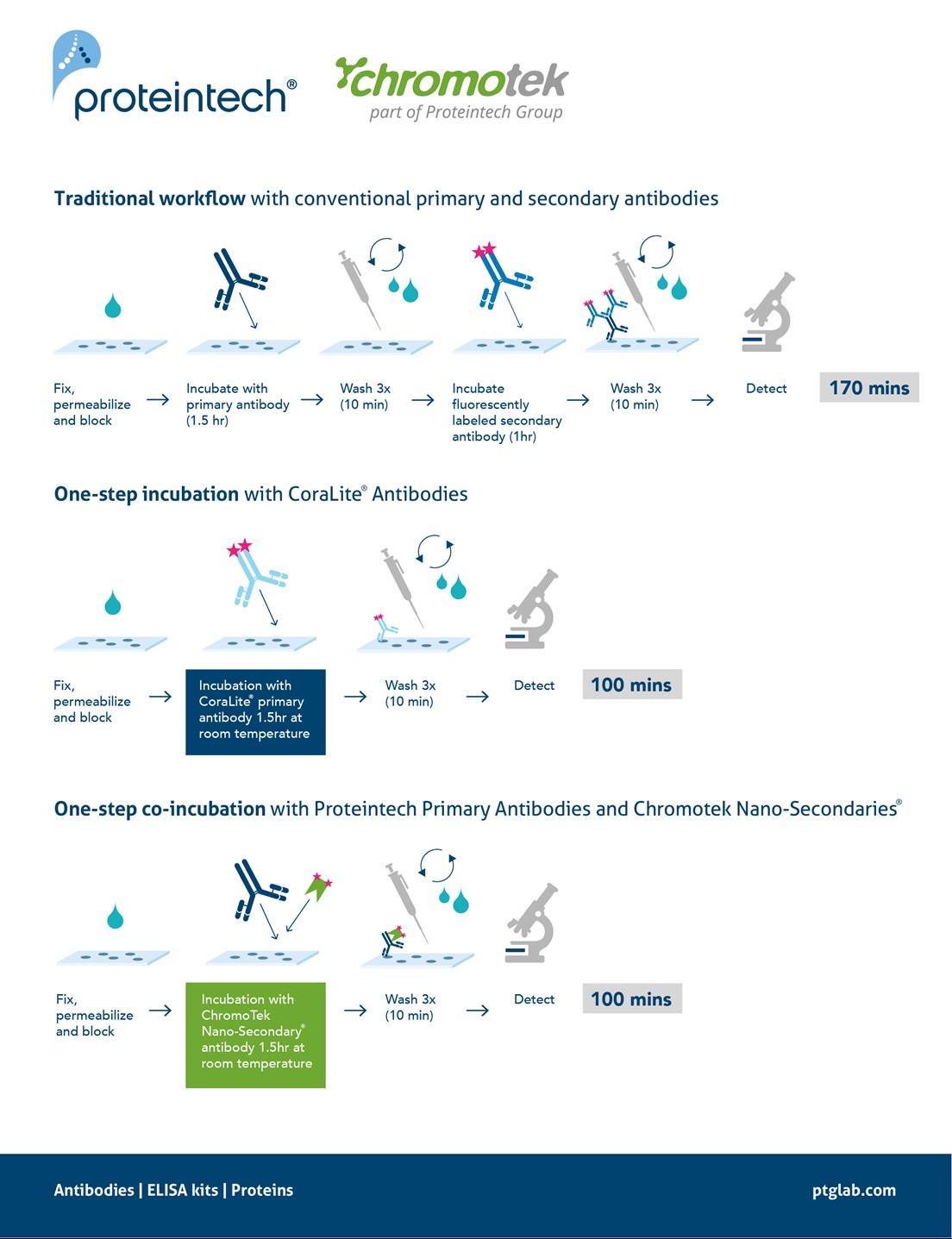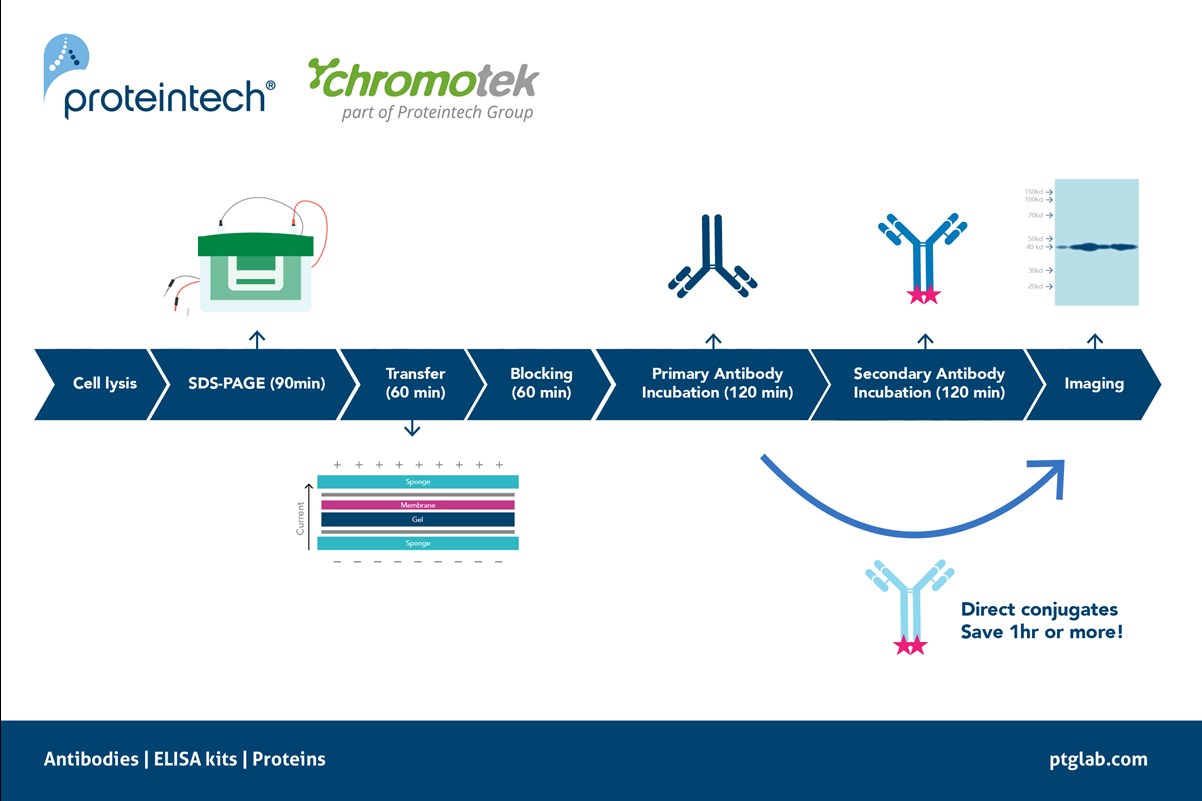Seizing the day: How to save time on your immunoassay experiments
When time in the lab is limited, learn how to save precious hours on your IP, IF, and western blotting experiments.
Due to the current situation with the COVID-19 pandemic, many researchers around the world are faced with restrictions on time and resources in the lab. As we adapt to these changes, the pressure is on to find ways to save time without compromising on results. Proteintech and ChromoTek offer solutions to save you hours on your current immunoassay protocols, helping you achieve publication worthy results in a fast and reliable manner.
Immunoprecipitation (IP)
IP experiments are lengthy. Samples are first incubated with the target antibody for 1 hour up to overnight. Afterwards, there is a 1-2 hour incubation step with protein A/G beads to precipitate the protein through centrifugation or magnetic methods. Lastly, it takes approximately 1 hour from the immunoprecipitation to elute the target protein. In all, a typical IP can take from 3 to 15 hours.
This can be far too long to wait for results. ChromoTek® has developed a series of antibody-bead conjugates for tagged fusion proteins that can isolate proteins in less than 2 hours. The antibodies are high affinity recombinant VHH fragments from alpacas called Nanobodies, which have faster binding rates. Consequently, incubation with the sample takes less than 1 hour for total protein capture. Since the Nanobodies are pre-conjugated with beads, the second incubation is unnecessary, and the protein can be analyzed soon afterward. These features result in a protocol duration of under 2 hours from start to finish (Figure 1). Find out more about our Nano-Trap products here.

Figure 1. Comparison of experiment duration for immunoprecipitation using GFP-Trap reagents vs. conventional anti-GFP antibody, saving over 1hr.
Immunofluorescence (IF)
IF experiments can often take a long time, sometimes over multiple days depending on preferred incubation lengths. Sample are first fixed, which can vary from less than 1 hour to 12 hours overnight. Afterwards, antigen retrieval and blocking steps are performed, lasting around 1-2 hours. Next, the samples are incubated with the primary antibody for as little as 1.5 hours or as long as 12 hours overnight. Lastly, the samples are incubated with the secondary antibody for typically around 2 hours. This results in the time it takes to perform an IF experiment ranging from 4.5 to more than 27 hours.
One way to save at least 2 hours in IF experiments is by using directly conjugated antibodies. We have developed our CoraLite® dye-conjugated antibodies to enable you to forego secondary antibody incubation and go straight to imaging (Figure 2). Our CoraLite® dye-conjugated antibody portfolio covers 400+ popular targets in cancer, neuroscience, and more. Learn more about this portfolio here.
If there are no directly conjugated antibodies for your target, ChromoTek’s Nano-Secondaries® can be used. Nano-Secondaries are secondary antibodies, consisting of Nanobodies (VHH) conjugated to fluorophores. Since Nano-Secondaries are monovalent and are specific to their target species IgG, they can be incubated alongside your primary antibody for a one-step co-incubation (Figure 2).

Figure 2. Time-saving comparisons for ImmunoFluorescence workflow using CoraLite® conjugated primaries or ChromoTek Nano-Secondaries® vs. a conventional protocol, saving at least 2 hours.
In addition, Nano-Secondaries are very small (one-tenth the size of a conventional antibody) and penetrate much faster; thus, incubation time can be reduced by up to 50%. Similar time savings can also apply to ChromoTek’s Nano-Booster/Nano-Label range. These are fluorescently labeled primary Nanobodies, which bind to tagged fusion proteins. Find out more about Nano-Secondaries and Nano-Booster/Nano-Labels here.
Western Blotting (WB)
WB experiments are another time-consuming process. Samples are loaded onto a SDS-PAGE gel and electrophoresed for 1.5 hours, in most cases. The proteins in the gel are then transferred to a membrane, which may take up to 1 hour or more. The membrane is then blocked for 1 hour. Afterwards, it is incubated with primary antibody for 2 to 12 hours overnight followed by the secondary antibody incubation, lasting another hour. Up to imaging, the duration of the entire experiment is 6.5 to 16.5 hours.
We offer several antibodies directly conjugated to horseradish peroxidase (HRP), enabling you to image after primary antibody incubation and save an hour (Figure 3). Targets include GAPDH, GFP, and beta actin. Browse all of them here. If fluorescent WB is your method of choice, then our CoraLite® dye-conjugated antibody portfolio is of benefit to you. All our popular control antibodies are fluorescently conjugated. In addition, your favorite primary antibodies can be used in fluorescent WB in conjunction with ChromoTek’s Nano-Secondaries with a one-step incubation process of primary and Nano-Secondary, saving you time.

Figure 3. Time saving comparisons for western blotting using Proteintech's directly conjugated primary antibodies, saving over 1 hour.


